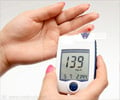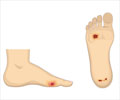- Skin Conditions in Diabetes - (http://my.clevelandclinic.org/health/diseases_conditions/hic_diabetes_basics/hic_skin_conditions_in_diabetes)
- Skin Complications - (http://www.diabetes.org/living-with-diabetes/complications/skin-complications.html)
- Good Skin Care and Diabetes - (http://www.joslin.org/info/good_skin_care_and_diabetes.html)
- Diabetic neuropathy - (http://www.mayoclinic.org/diseases-conditions/diabetic-neuropathy/basics/symptoms/con-20033336)
Diabetes and Skin Care
Diabetes mellitus is a chronic, metabolic disorder characterized by elevated blood glucose levels, due to an absolute or relative insulin deficiency, and is associated with numerous complications including those involving the skin.
Proper skin care in diabetes involves keeping blood sugar levels under control and measures to prevent skin complications.

Interesting Statistics about Diabetes Mellitus
- Worldwide, the number of persons having diabetes has increased from 108 million in 1980 to a staggering 422 million in 2014. It is increasing faster in the small and middle-income countries.
- Globally, the prevalence of diabetes among adults i.e. people over 18 years has risen from 4.7% in 1980 to 8.5% in 2014.
- According to the WHO, diabetes may become the seventh most common cause of death by 2030.
- In 2012 alone, diabetes was directly responsible for about 1.5 million deaths, and yet another 2.2 million deaths were estimated to be due to high blood glucose levels.
- Diabetes remains a major reason for heart attacks, strokes, blindness, kidney failure and lower limb amputations.
Diabetes and Skin Complications
Diabetes, not only causes serious complications such as those listed above, it can also affect the skin in many ways. The most common complications involving the skin in diabetes are discussed below:
1. Bacterial infections
Bacterial infections in diabetes can take numerous forms. These include
- Styes – infections of the glands of the eyelid
- Folliculitis – hair follicle infections
- Carbuncle – Group of infected boils of the skin
- Acute paronychia – Infection around nails
The part of the skin involved by bacterial infection appears typically red, swollen and painful. These infections take longer to heal compared to infections occurring in non-diabetic individuals. This is because microbes thrive in a glucose-rich environment. Most of these infections need to be managed with antibiotics either as pills or topical applications such as creams.
2. Fungal infections
The yeast-like fungus Candida albicans is responsible for a majority of fungal infections in diabetic patients. The infections occur in warm, moist areas of the skin such as beneath skin folds, and in the groin and axilla. The lesions consist of itchy rashes bordered by minute blisters and scales.
Management of these infections involve keeping these areas dry, and application of topical steroids and antifungal medications. Control of diabetes is critical to prevent recurrent infections.

3. Itching or Pruritis
Itching in diabetes can be due to various reasons such as fungal infections, dryness of skin or poor circulation. The lower limbs are most often affected when blood circulation is poor.
Some of the treatment methods involve:
- Application of lotions and creams to keep the skin moist
- Hot showers must be avoided
- Strong soaps that dehydrate the skin should be avoided
- Put feet up to improve circulation
4. Vitiligo
This condition involves formation of light or white patches of the skin due to destruction of the cells that make melanin (a pigment responsible for skin coloration). It occurs more commonly in patients with type 1 diabetes.
These depigmented lesions occur mostly on the elbows, knees and hands. Other parts that may be affected include the areas around the mouth, the nostrils and eyes. They do not produce symptoms but can be distressing due to the cosmetic effect, especially in persons with darker skin.
Treatment includes
- Application of topical steroids
- Tattooing (micropigmentation) to darken the light lesions
- Use of a sunscreen having a SPF of 30 or more to prevent sunburn of the affected area.

5. Skin Changes due to Diabetic Neuropathy
Diabetic neuropathy refers to the symptoms caused by nerve damage. The high blood sugar levels are thought to damage nerve fibers by unknown mechanisms. Peripheral neuropathy causes symptoms like tingling and burning, and loss of sensations over extremities. Some people develop blisters that look like burn blisters. These lesions are called ‘bullosis diabeticorum.’ Repeated injuries in insensitive areas can cause foot ulcers, infections, and subsequent deformities. The patient should protect the insensitive parts from injuries.
6. Allergic Reactions to Insulin
An allergic reaction in the form of rashes or bumps may occur to insulin. Patients taking insulin injections should look for such lesions in the injected area. Milder forms of allergic reactions may be treated with antihistamines. Severe reactions necessitate emergency treatment. In some cases, switching over to a different type of insulin might help.
7. Eruptive Xanthomatosis
These lesions appear as firm, yellow and pea sized bumps with red halos. They might be often itchy. They occur on the arms, legs and feet, back of hands and buttocks.
They occur when blood glucose levels are poorly controlled and the blood triglyceride levels are high.
Treatment involves control of blood sugar levels, and medications to bring down the lipid levels.

8. Digital Sclerosis
Digital sclerosis is a condition where the skin on the fingers and toes becomes thick, shiny and stretched. Joint stiffness may also occur.
Treatment involves better diabetic control, and application of moisturizers and creams to keep the skin soft.
9. Disseminated Granuloma Annulare
These lesions are ring or arc shaped sharply delineated rashes that may be red, brown or even skin coloured. They are seen on the fingers and ears often, but can also occur on the skin of the abdomen and chest.
No treatment is necessary, though a topical steroid such as hydrocortisone can be beneficial.
10. Acanthosis nigricans
It is seen in overweight people, and often precedes the onset of diabetes, and is in fact considered a marker of diabetes. It is thought to be a manifestation of insulin resistance.
The affected areas appear dark, thick and sometimes raised and have an appearance described as ‘velvety’. They can occur on the sides or back of the neck, armpits, beneath the breast, and groin.
The condition may improve with losing weight.
Skin Care Tips in Diabetes
It is essential to keep the blood sugar under control. The following additional measures may also aid in skin care and prevention of complications.
- Drink plenty of water and sugar-free drinks that will keep the skin well hydrated.
- Proper control of associated conditions such as high blood pressure and high cholesterol is critical to improving the blood circulation.
- Look for any signs of infection such as rash, blisters or boils and seek medical attention immediately.
- Avoid tight footwear or walking barefoot. Regular checkups to monitor the condition of feet and extremities is critical to avoiding serious complications.
- Consume foods rich in omega-3 fatty acids such as fish, salmon, walnuts, flax seeds and soya. These keep the skin healthy.








